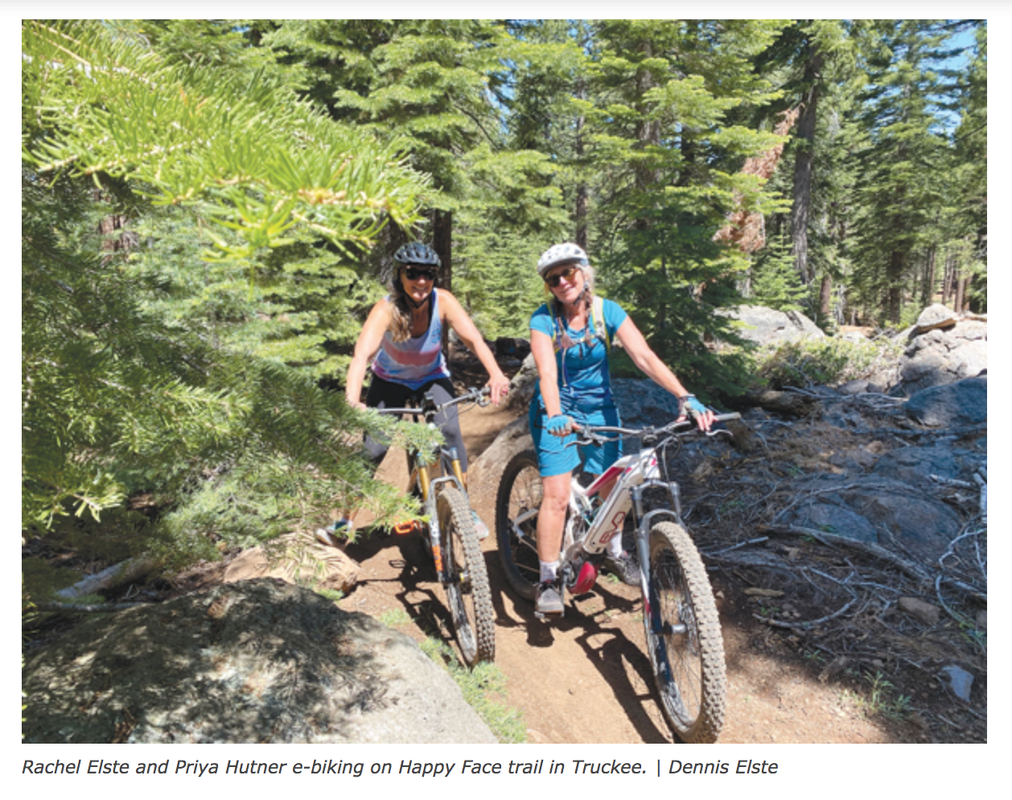Electric mountain bikes are opening the door to increased access to public lands, a key takeaway from the E-Mountain Bike Summit held in Olympic Valley in mid-September.
As the use of e-bikes continues to grow in popularity, the positive attributes of e-bikes seemingly outweigh the negative in many regards, including for those with physical limitations being able to access trails and ride further and a family’s ability to ride and spend time together. Not to mention health benefits and the reduction of climate change impacts.
I joined industry leaders, land managers, bike shop owners and mountain bike enthusiasts for the summit to discuss the future of electric mountain biking, trail access and the growth and stigma of the sport.
Tahoe was a natural choice to hold the summit as the Tahoe National Forest is leading the way for e-mountain bike access in U.S. Forest Service districts across the county. The summit was organized by People for Bikes, an advocacy group that seeks to improve biking and focuses on making bike riding safer and easier to access.
E-mountain bikes comprise 3 percent of all new mountain bike sales in the last 12 months nationwide, according to Patrick Hogan of People for Bikes.
While e-bikes are still classified as motorized vehicles, it’s important to note the differences in the three classes of electric bikes. At the summit, the discussion regarding trail access was limited to Class 1 e-mountain bikes, which are pedal-assist bikes. This class of bike does not have a throttle to propel the bike.
Forest Service access
The Tahoe National Forest, which includes the Truckee, Sierraville, American River and Yuba River ranger districts and encompasses more than 1 million acres of public lands, is leading the nation in opening trails to e-mountain bike access, which Tahoe National Forest District Ranger Jonathan Cook-Fisher and USDA Forest Service Acting Deputy Director and Regional Forester Eli Ilano, discussed at the summit.
In March 2021, Tahoe National Forest designated 35 miles of the Forest’s 682 non-motorized trails as open to Class 1 e-bikes (read our story at TheTahoeWeekly.com). This includes the Big Chief, Commemorative Overland Emigrant, Donkeytown (aka Jackass) and Sawtooth trails.
The pair outlined the East Zone Connectivity and Restoration Project adopted last year, which includes the construction of 71 miles of motorized single-track, decommissioning 41 miles of unauthorized roads and trails, and improving and developing 11 staging areas.
Cook-Fisher and Ilano shared details from U.S. Forest Service studies that showed that e-mountain bikes’ impact on wildlife, soil, water and vegetation was minimal, and the impact, if any, was the same as regular mountain bikes. Ilano also pointed out that studies examined the difference between a standard mountain bike and an e-mountain bike regarding speed. E-mountain bikes are faster on the uphill and on the downhill they average a similar speed as a regular mountain bike.
Cook-Fisher also noted that Lake Tahoe Basin Management Unit is working to expand e-bike access on public lands around Lake Tahoe.
Overcoming stigmas
E-bike stigma was also discussed during the summit. Cook-Fisher likened the e-mountain bike stigma to the issue of snowboarding versus skiing in the 1990s. The idea that e-bikes are cheater bikes is another stigma the e-mountain bike community faces.
Impacts of climate change
Climate change was another topic that was explored during the summit, with advocates pointing out that getting more people on bikes and reducing drivers on the road is one of the positive impacts of the e-bike explosion.
During one breakout session, Steven Sheffield, team leader of product management and business development for Bosch E-Bike Systems, and Aaron Clark, government affairs policy manager for International Mountain Bicycling Association, discussed how ski resorts can best use their properties in the face of warmer temperatures, shorter ski seasons and declining snowpack. Opening downhill runs during the summer for e-mountain biking is one way to create year-round recreation for ski resorts. Sheffield used Mammoth Mountain as an example of embracing e-mountain biking at its mountain. Locally, Northstar, Kirkwood and Sky Tavern ski areas are open for e-mountain biking in the summer.
As the popularity of e-bikes continues to expand, Tahoe Weekly will continue to cover e-bike use and access in the Tahoe Sierra. | peopleforbikes.org, fs.usda.gov
E-bike classes
- Class 1 | E-bikes provide pedal-assisted motor power up to 20 mph; users have to pedal to receive the extra energy. There is no throttle.
- Class 2 | E-bikes have a throttle that can power up to 20 mph without pedaling, so it’s more like a moped.
- Class 3 | E-bikes provide pedal assistance only, but up to 28 mph.
https://thetahoeweekly.com/2022/09/electric-mountain-bike-access-tahoe-national-forest-leading-the-way/



 RSS Feed
RSS Feed